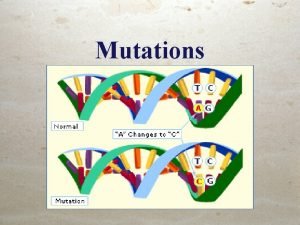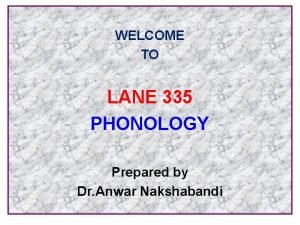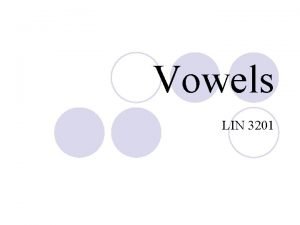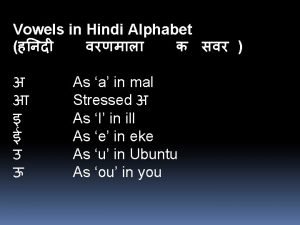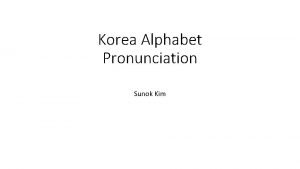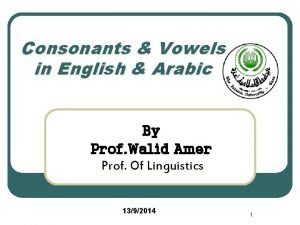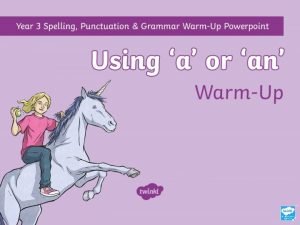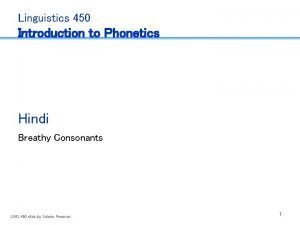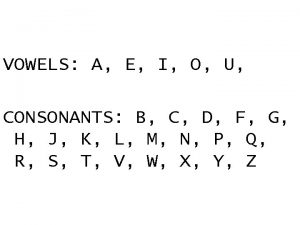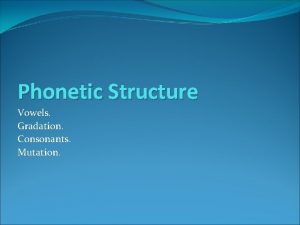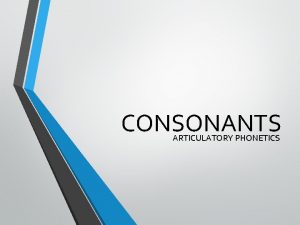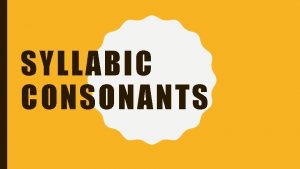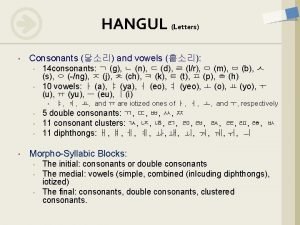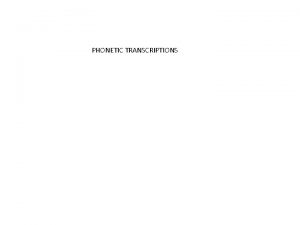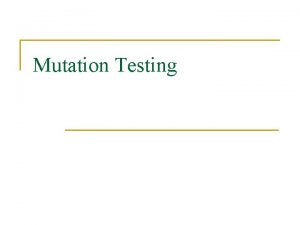Phonetic Structure Vowels Gradation Consonants Mutation Vowels All













- Slides: 13

Phonetic Structure Vowels. Gradation. Consonants. Mutation.

Vowels �All OE vowels, including diphthongs. Can be either short or long. �Monophtongs: a æ e i o u y å �Diphthongs : ea eo ie io

�æ sounded like Mn. E {æ} in man, hat �y was sounded like German ü in Mütter �ā may occur in any type of syllable. It corresponds to Goth. ai, e. g. stān “stone”, hātan “call”

Gradation �In Indo-European languages there is a special kind of vowel alternation, usually called gradation, or ablaut. reisan “rise “ rias risum risans kiusan “choose” kaus kusum kusans bindan “bind” band bundum bundans

�The original Germanic gradation system, which was rather clearly preserved in the 4 th century gothic text, has been to a great extent obscured even in the earliest OE texts, owing to a number of phonetic changes. �Let’s see the alternation i/a/ zero: reisan- rais- risum -risans

Consonants Labial: p, b, m, f, v Consonants Velar: c, z, h Dental: t, d, ₫, n, s, r, l

Mutation � By mutation , or umlaut we mean a change of vowel caused by partial assimilation to the following vowel. � i- mutation the most important type of mutation is that caused by an i (or j) of the following syllable. This type is usually referred to as mutation. Mutation brings about a complete change in vowel quality: one phoneme is replaced by another. In OE i-mutation affects practically all vowels. Only short e and I have no connection with it. *fullian > fyllan

� Monophtongs �a > e framian > fremman “perform” sandian > sendan “send” namnian > nemnan “name” æ > e tælian > tellan “tell” sælian > sellan “give” o > e ofstain > efstan “hurry”

Diphtongs �ea > ie earmiþu > iermþu “poverty” �ēa > īe zelēafian > zel īefan “believe” � eo > ie afeorrian > afierran “remove”. This ie also often becomes ī, ŷ : afirran, afyrran

� The i-mutation was significant for the phonemic structure of OE. As a result of it a new phoneme arose which was different from the original one. �The phoneme (e) which appeared as a result of imutation of (æ) as in tellan , net had existed in the words etan “eat ”.

�a short /ɑ/. Spelling variations like ‹land› ~ ‹lond› "land" suggest it may have had a rounded allophone [ɒ] before [n] in some cases) �ā long /ɑː/. Rarely found in manuscripts, but usually distinguished from short ‹a› in modern editions. �æ short /æ/. Before 800 the digraph ‹ae› is often found instead of ‹æ›. During the 8 th century ‹æ› began to be used more frequently was standard after 800. In 9 th century Kentish manuscripts, a form of ‹æ› that was missing the upper hook of the ‹a› part was used. Kentish ‹æ› may be either /æ/ or /e/ although this is difficult to determine. �ǽ long /æː/. Rarely found in manuscripts, but usually distinguished from short ‹æ› in modern editions.

�e short /e/. �ę either Kentish /æ/ or /e/ although this is difficult to determine. A modern editorial substitution for a form of ‹æ› missing the upper hook of the ‹a› found in 9 th century texts. �ē long /eː/. Rarely found in manuscripts, but usually distinguished from short ‹e› in modern editions. �ea short /æɑ/; after ‹ċ›, ‹ġ›, sometimes /æ/ or /ɑ/. �ēa long /æːɑ/. Rarely found in manuscripts, but usually distinguished from short ‹ea› in modern editions. After ‹ċ›, ‹ġ›, sometimes /æː/. �eo short /eo/; after ‹ċ›, ‹ġ›, sometimes /o/ �ēo Long /eːo/. Rarely found in manuscripts, but usually distinguished from short ‹eo› in modern editions.

Thank you!
 What is ipa?
What is ipa? English ipa alphabet
English ipa alphabet Mutation is any mistake or change in the
Mutation is any mistake or change in the Difference between vowels and consonants
Difference between vowels and consonants Difference between consonant and vowel
Difference between consonant and vowel Mal alphabet
Mal alphabet Vowel korean
Vowel korean Difference between a vowel and a consonant
Difference between a vowel and a consonant Consonant vowel sort
Consonant vowel sort Hindi ipa chart
Hindi ipa chart Hebrew vowels
Hebrew vowels A e i o u consonant
A e i o u consonant What is tense vowels
What is tense vowels Name all rays
Name all rays


